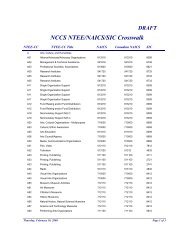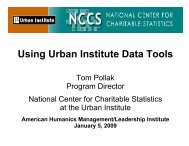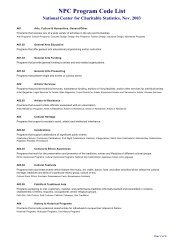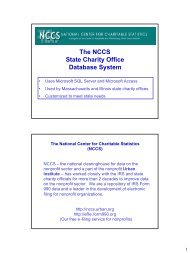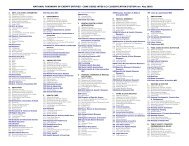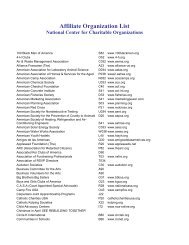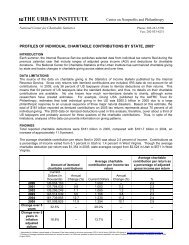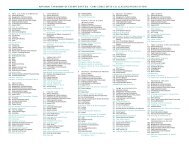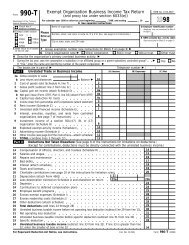Variations in Overhead and Fundraising Efficiency Measures: The ...
Variations in Overhead and Fundraising Efficiency Measures: The ...
Variations in Overhead and Fundraising Efficiency Measures: The ...
Create successful ePaper yourself
Turn your PDF publications into a flip-book with our unique Google optimized e-Paper software.
<strong>Variations</strong> <strong>in</strong> <strong>Overhead</strong> <strong>and</strong> Fundrais<strong>in</strong>g <strong>Efficiency</strong> <strong>Measures</strong>:<br />
<strong>The</strong> Influence of Size, Age, <strong>and</strong> Subsector<br />
Mark A. Hager<br />
Center on Nonprofits <strong>and</strong> Philanthropy<br />
<strong>The</strong> Urban Institute<br />
Thomas Pollak<br />
Center on Nonprofits <strong>and</strong> Philanthropy<br />
<strong>The</strong> Urban Institute<br />
Patrick Rooney<br />
Center on Philanthropy<br />
Indiana University<br />
<strong>Overhead</strong> Cost Study Work<strong>in</strong>g Paper<br />
Earlier versions of this paper (revised title) presented at the<br />
2000 Annual Conference of the Association of Fundrais<strong>in</strong>g Professionals, San Diego<br />
<strong>and</strong> the<br />
2001 Annual Conference of the<br />
Association for Research on Nonprofit Organizations <strong>and</strong> Voluntary Action, Miami
<strong>Variations</strong> <strong>in</strong> <strong>Overhead</strong> <strong>and</strong> Fundrais<strong>in</strong>g <strong>Efficiency</strong> <strong>Measures</strong>:<br />
<strong>The</strong> Influence of Size, Age, <strong>and</strong> Subsector<br />
<strong>The</strong> desire of <strong>in</strong>dividual donors <strong>and</strong> <strong>in</strong>stitutional funders to know how their money is<br />
spent, along with the <strong>in</strong>creas<strong>in</strong>g availability of f<strong>in</strong>ancial <strong>in</strong>formation on nonprofit organizations,<br />
has <strong>in</strong>creased the use <strong>and</strong> abuse of f<strong>in</strong>ancial measures of nonprofit efficiency. We focus on two<br />
measures: the proportion of budget spent on non-program expenses <strong>and</strong> the ratio of fundrais<strong>in</strong>g<br />
expenses to contributions. We hypothesize variations <strong>in</strong> these measures by organizational size,<br />
age, <strong>and</strong> subsector, <strong>and</strong> we test these hypotheses with data reported by the organizations to the<br />
Internal Revenue Service. We conclude that the ratio measures vary by organizational<br />
characteristics, a factor both widely cited by watchdog groups <strong>and</strong> overlooked by agents that<br />
attempt to apply the measures to nonprofit organizations without regard for systematic variation.<br />
We also conclude that other factors besides size, age, <strong>and</strong> subsector are important <strong>in</strong> expla<strong>in</strong><strong>in</strong>g<br />
the relative efficiencies of nonprofit organizations.<br />
1
<strong>Variations</strong> <strong>in</strong> <strong>Overhead</strong> <strong>and</strong> Fundrais<strong>in</strong>g <strong>Efficiency</strong> <strong>Measures</strong>:<br />
<strong>The</strong> Influence of Size, Age, <strong>and</strong> Subsector<br />
People care about the ways that nonprofit organizations spend their contributions<br />
(Greenlee & Brown 1999; Parsons 2001). However, despite pressures for nonprofit<br />
organizations to conform to donor dem<strong>and</strong>s, watchdog guidel<strong>in</strong>es, <strong>and</strong>, <strong>in</strong> some cases,<br />
contractual requirements to ma<strong>in</strong>ta<strong>in</strong> a certa<strong>in</strong> level of f<strong>in</strong>ancial efficiency, little is known about<br />
the relative efficiencies of nonprofit organizations. This research report summarizes how the<br />
relationships between revenues <strong>and</strong> overhead costs on the one h<strong>and</strong>, <strong>and</strong> fundrais<strong>in</strong>g costs <strong>and</strong><br />
contributions on the other, are distributed by organizational size, age, <strong>and</strong> subsector. <strong>The</strong> report<br />
concludes that these ratios vary by these organizational characteristics, <strong>and</strong> that <strong>in</strong>dividual<br />
donors, nonprofit watchdog groups, <strong>in</strong>stitutional funders, journalists <strong>and</strong> researchers can benefit<br />
from underst<strong>and</strong><strong>in</strong>g the differences. However, we also conclude that these factors expla<strong>in</strong> only a<br />
small amount of the variation <strong>in</strong> the cost ratios, a f<strong>in</strong>d<strong>in</strong>g that po<strong>in</strong>ts to the need for future<br />
research on this topic.<br />
We undertake this work with the underst<strong>and</strong><strong>in</strong>g that nonprofit organizations experience<br />
pressures to manage the way they are perceived by their constituencies. <strong>The</strong>se pressures, along<br />
with the differences <strong>in</strong> how managers account for the dollars that flow through their<br />
organizations, result <strong>in</strong> formal report<strong>in</strong>g documents that only approximate the realities of what<br />
goes on <strong>in</strong>side of organizations. "Nonprofit organizational effectiveness," writes Herman <strong>and</strong><br />
Renz (1999: 118), "is a social construction." When one compares the report<strong>in</strong>g documents of<br />
two nonprofit organizations, one often concludes that the idiosyncrasies of their situations <strong>and</strong><br />
their account<strong>in</strong>g processes make a comparison of f<strong>in</strong>ancial efficiencies difficult. Indeed, recent<br />
reviews of publicly available data on nonprofits (i.e. Lampk<strong>in</strong> <strong>and</strong> Pollak 2001; Brostek 2002;<br />
2
Froelich, Knoepfle <strong>and</strong> Pollak 2000; Gordon, Khumawala <strong>and</strong> Kraut 2001) range from guarded<br />
to cautiously optimistic <strong>in</strong> their assessment of the reliability of f<strong>in</strong>ancial report<strong>in</strong>g documents.<br />
Nonetheless, the proliferation of publicly available data on nonprofit organizations <strong>in</strong>vites these<br />
comparisons (Frumk<strong>in</strong> 2001), which are rout<strong>in</strong>ely trumpeted as a primary guide for decisions<br />
about charitable giv<strong>in</strong>g. Consequently, <strong>and</strong> despite our concerns about the limitations of the<br />
data, we offer benchmarks for underst<strong>and</strong><strong>in</strong>g several common f<strong>in</strong>ancial ratios.<br />
A Brief Review of Relevant Studies<br />
Individuals give to organizations that they like. Individuals like organizations that work<br />
on causes they th<strong>in</strong>k are important, <strong>and</strong> that use their contributions <strong>in</strong> responsible ways. A 1988<br />
Roper Organization survey found that an adequate amount spent for program was the second<br />
most important factor <strong>in</strong> the decision to contribution to a nonprofit, a factor that was rated as<br />
important or very important by 82 percent of respondents (Glaser 1994). Doble (1990) reported<br />
from focus group research where participants felt that 75 percent of contributions should be spent<br />
on programs, although they suspect that nonprofits actually spend less than 50 percent on<br />
programs.<br />
More recently, Stehle (1998) reported on a study from the Hudson Institute on the<br />
attitudes Americans have toward public charities. While nearly three-quarters of the respondents<br />
said that the organization’s mission <strong>in</strong>fluences their giv<strong>in</strong>g decisions, nearly half said that they<br />
care how much the potential recipients of their giv<strong>in</strong>g spend on adm<strong>in</strong>istration <strong>and</strong> fundrais<strong>in</strong>g.<br />
<strong>The</strong>se numbers were even more pronounced among wealthy respondents, with 87 percent<br />
concerned with a charity’s goals <strong>and</strong> 64 percent attuned to fundrais<strong>in</strong>g costs.<br />
3
Still more recently, a public op<strong>in</strong>ion poll by Pr<strong>in</strong>ceton Survey Research Associates<br />
(PSRA, 2001) asked Americans what k<strong>in</strong>d of <strong>in</strong>formation is most important when mak<strong>in</strong>g giv<strong>in</strong>g<br />
decisions. Nearly half of the respondents focused on how the organization uses its money. In<br />
contrast, 13 percent focus on an organization's legitimacy or reputation, <strong>and</strong> only 6 percent cited<br />
fulfills a genu<strong>in</strong>e need or makes a difference as the primary impetus for giv<strong>in</strong>g.<br />
Several academic studies (T<strong>in</strong>kelman 1999; Greenlee <strong>and</strong> Brown 1999) support the<br />
notion that f<strong>in</strong>ancial <strong>in</strong>formation about a charity plays a role <strong>in</strong> the allocation of donor resources.<br />
While program performance is important, a charity's f<strong>in</strong>ancial performance may well play a large<br />
role <strong>in</strong> its reputation <strong>and</strong> ability to garner future resources. S<strong>in</strong>ce f<strong>in</strong>ancial <strong>in</strong>formation is more<br />
widely available <strong>and</strong> more easily compared across organizations, it has become a primary means<br />
by which charities are evaluated as worthy recipients of the public’s contributions.<br />
Guidel<strong>in</strong>es <strong>and</strong> <strong>Measures</strong><br />
Several non-governmental organizations observe charities <strong>and</strong> promulgate st<strong>and</strong>ards of<br />
ethical <strong>and</strong> efficient operations. <strong>The</strong>se entities are frequently referred to as “watchdog”<br />
organizations. Hopk<strong>in</strong>s (2002) has observed that the <strong>in</strong>fluence of the watchdogs is decl<strong>in</strong><strong>in</strong>g due<br />
to the <strong>in</strong>crease <strong>in</strong> disclosure of <strong>in</strong>formation about charities <strong>and</strong> the rise <strong>in</strong> accessibility to this<br />
<strong>in</strong>formation by means of the Internet. Nonetheless, these charities rema<strong>in</strong> the primary source of<br />
normative guidel<strong>in</strong>es on such issues as accountability, fundrais<strong>in</strong>g, <strong>and</strong> governance. <strong>The</strong> most<br />
visible national watchdog is the Wise Giv<strong>in</strong>g Alliance, a recent merger of the National Charities<br />
Information Bureau (NCIB) <strong>and</strong> the Council of Better Bus<strong>in</strong>ess Bureau’s Philanthropic Advisory<br />
Service. Another is the American Institute of Philanthropy (AIP). i<br />
4
Both the Wise Giv<strong>in</strong>g Alliance <strong>and</strong> the AIP discuss two common f<strong>in</strong>ancial measures.<br />
<strong>The</strong>se measures go by a variety of names, but we adopt <strong>Overhead</strong> Ratio <strong>and</strong> Fundrais<strong>in</strong>g Cost<br />
Ratio <strong>in</strong> this paper. ii We def<strong>in</strong>e <strong>and</strong> discuss these ratios <strong>in</strong> the rema<strong>in</strong>der of this section, <strong>and</strong> then<br />
hypothesize the relationships between these ratios <strong>and</strong> <strong>in</strong>stitutional characteristics <strong>in</strong> the<br />
follow<strong>in</strong>g section. Follow<strong>in</strong>g that, we <strong>in</strong>troduce our data <strong>and</strong> tests of the hypotheses. We<br />
conclude with a discussion of the results <strong>and</strong> several conclusions about the measures <strong>and</strong> the<br />
mean<strong>in</strong>gs we attribute to them.<br />
1. <strong>Overhead</strong> Ratio: Fundrais<strong>in</strong>g <strong>and</strong> Adm<strong>in</strong>istrative costs as a proportion of Total Revenues<br />
<strong>Overhead</strong> Ratio can be thought of as the amount of total receipts spent on adm<strong>in</strong>istration <strong>and</strong><br />
fundrais<strong>in</strong>g, <strong>in</strong> contrast to the amount spent deliver<strong>in</strong>g services. <strong>The</strong> Wise Giv<strong>in</strong>g Alliance<br />
advances its “St<strong>and</strong>ards of Charitable Solicitations,” derived largely from the longst<strong>and</strong><strong>in</strong>g<br />
“St<strong>and</strong>ards <strong>in</strong> Philanthropy” established by the NCIB. Accord<strong>in</strong>g to the st<strong>and</strong>ards, charities<br />
should spend at least 50 percent of total <strong>in</strong>come on program activities. This st<strong>and</strong>ard diverges<br />
from the orig<strong>in</strong>al NCIB st<strong>and</strong>ard, which set the <strong>Overhead</strong> Ratio at 40 percent of total<br />
expenditures.<br />
<strong>The</strong> American Institute of Philanthropy adopts a more str<strong>in</strong>gent st<strong>and</strong>ard, not<strong>in</strong>g that “60<br />
percent or greater [of total expenditures on charitable programs] is reasonable for most<br />
charities.” Rather than rely on the allocation decisions made by the charities they watch,<br />
however, AIP allocates portions of jo<strong>in</strong>t fundrais<strong>in</strong>g/education appeals to fundrais<strong>in</strong>g if the<br />
charity has represented the costs as educational program costs. That is, AIP recognizes at least<br />
5
one of the common vagaries of nonprofit account<strong>in</strong>g <strong>and</strong> tries to adjust its ratios to reflect a more<br />
accurate representation of how nonprofits spend their money.<br />
2. Fundrais<strong>in</strong>g Costs Ratio: Fundrais<strong>in</strong>g Costs as a proportion of Contributions<br />
<strong>The</strong> Fundrais<strong>in</strong>g Costs Ratio can be thought of as the amount that an organization spent<br />
to raise each dollar it received from contributors. While the NCIB did not orig<strong>in</strong>ally offer a<br />
numerical guidel<strong>in</strong>e for fundrais<strong>in</strong>g efficiency, the Wise Giv<strong>in</strong>g Alliance now suggests that<br />
“fundrais<strong>in</strong>g costs [should] not exceed 35 percent of related contributions." However, follow<strong>in</strong>g<br />
the NCIB tradition, the Wise Giv<strong>in</strong>g Alliance acknowledges that different organizations may<br />
need to be held to different st<strong>and</strong>ards. “<strong>The</strong> higher fundrais<strong>in</strong>g <strong>and</strong> adm<strong>in</strong>istrative costs of a<br />
newly created organization, donor restrictions on the use of funds, exceptional bequests, a stigma<br />
attached with a cause, <strong>and</strong> environment or political events beyond an organization’s control,”<br />
they suggest, “are among the factors which may result <strong>in</strong> costs that are reasonable although they<br />
do not meet these percentage limitations.”<br />
Similarly, AIP notes that “$35 or less to raise $100 is reasonable for most charities.”<br />
Similar to their adjustments for jo<strong>in</strong>t program/fundrais<strong>in</strong>g efforts, AIP also adjusts fundrais<strong>in</strong>g<br />
expenses if organizations have not allocated all of the costs of direct mail <strong>and</strong> telemarket<strong>in</strong>g to<br />
fundrais<strong>in</strong>g expenses. AIP extols the Fundrais<strong>in</strong>g Costs Ratio as useful “because it tells donors<br />
how much a charity is spend<strong>in</strong>g to obta<strong>in</strong> your contribution <strong>and</strong> how much is left to spend on<br />
charitable programs <strong>and</strong> general adm<strong>in</strong>istration.”<br />
While the watchdog organizations consistently po<strong>in</strong>t to the need to consider the f<strong>in</strong>ancial<br />
or environmental circumstances of the nonprofit organizations they evaluate, others do not<br />
6
always provide this courtesy. Institutional funders <strong>and</strong> federated drives often offer their dollars<br />
or services to charities that meet a strict <strong>and</strong> uniformly applied st<strong>and</strong>ard. Similarly, journalists<br />
frequently apply a strict st<strong>and</strong>ard without regard for how their measures vary across sub-<br />
populations or organizational characteristics. Benjam<strong>in</strong> (2000) notes that popular magaz<strong>in</strong>es<br />
such as Money, Kipl<strong>in</strong>ger’s Personal F<strong>in</strong>ance, <strong>and</strong> U.S. News <strong>and</strong> World Report publish annual<br />
articles on charitable giv<strong>in</strong>g to help donors identify worthy nonprofit organizations. “With few<br />
exceptions,” writes Benjam<strong>in</strong>, “these articles focus on evaluat<strong>in</strong>g nonprofits accord<strong>in</strong>g to the<br />
percentage of funds spent on adm<strong>in</strong>istration <strong>and</strong> fundrais<strong>in</strong>g. In fact, every year Money ranks<br />
charities solely accord<strong>in</strong>g to what percentage of their total <strong>in</strong>come is spent on programs….”<br />
Both Guidestar <strong>and</strong> the Comb<strong>in</strong>ed Federal Campaign, two key entry po<strong>in</strong>ts for <strong>in</strong>formation<br />
regard<strong>in</strong>g giv<strong>in</strong>g to <strong>in</strong>dividual charities, emphasize the f<strong>in</strong>ancial position of charities. Some<br />
watchdog groups, e.g. Charity Navigator iii , develop their profiles of charities exclusively on<br />
f<strong>in</strong>ancial <strong>in</strong>formation.<br />
Although the public, journalists, <strong>and</strong> funders are <strong>in</strong>terested <strong>in</strong> fundrais<strong>in</strong>g <strong>and</strong><br />
adm<strong>in</strong>istrative cost ratios, researchers (outside of their occasional use as <strong>in</strong>dependent variables <strong>in</strong><br />
regression models) have given little attention to them. <strong>The</strong> purpose of the research reported <strong>in</strong><br />
this paper is to beg<strong>in</strong> to address this gap by explor<strong>in</strong>g the variation <strong>in</strong> these ratios by<br />
organizational size, age, <strong>and</strong> subsector, <strong>and</strong> to determ<strong>in</strong>e the extent to which these factors expla<strong>in</strong><br />
variation <strong>in</strong> the cost ratios. To this end, we advance eight hypotheses regard<strong>in</strong>g these<br />
relationships, test them with data from a population of nonprofit organizations, <strong>and</strong> discuss the<br />
outcomes.<br />
7
Hypotheses<br />
All of our hypotheses take as their start<strong>in</strong>g po<strong>in</strong>t the supposition that organizational<br />
characteristics <strong>in</strong>fluence the efficiencies of nonprofit organizations. First, we presume that the<br />
<strong>Overhead</strong> Ratio will vary by the size of a nonprofit. Larger organizations are able to take<br />
advantage of economies of scale, while smaller organizations must endure relatively higher<br />
proportional expenses for sunk costs. For example, the costs of phone or computer network<br />
systems <strong>and</strong> services are not substantially different for small <strong>and</strong> large organizations. <strong>The</strong> same<br />
might be said for payroll services, legal consultants, <strong>and</strong> fundrais<strong>in</strong>g counsel. <strong>The</strong>se costs<br />
represent a base of non-program costs that represent a greater proportion of the budget of a small<br />
organization than a larger one. <strong>The</strong>refore,<br />
H1: <strong>The</strong> larger an organization, the lower the proportion of budget spent on adm<strong>in</strong>istration <strong>and</strong><br />
fundrais<strong>in</strong>g.<br />
Second, we presume that the <strong>Overhead</strong> Ratio will also vary with the age of a nonprofit<br />
organization. This presumption is rooted <strong>in</strong> St<strong>in</strong>chcombe's (1965) liability of newness argument,<br />
which po<strong>in</strong>ts to the lack of rout<strong>in</strong>es, competencies, work<strong>in</strong>g relationships, <strong>and</strong> clients that<br />
younger organizations have to overcome <strong>in</strong> order to survive. In short, we believe that younger<br />
organizations will have to spend more money on adm<strong>in</strong>istration <strong>and</strong> fundrais<strong>in</strong>g <strong>in</strong> order to<br />
establish their organization's reputation <strong>and</strong> build a donor base. This suggests the second<br />
hypothesis,<br />
H2: <strong>The</strong> older an organization, the lower the proportion of budget spent on adm<strong>in</strong>istration <strong>and</strong><br />
fundrais<strong>in</strong>g.<br />
8
Third, we presume that the <strong>Overhead</strong> Ratio will vary depend<strong>in</strong>g on the subsector that the<br />
nonprofit organization is operat<strong>in</strong>g <strong>in</strong>. Galaskiewicz <strong>and</strong> Bielefeld (1998) contend that an<br />
organization's primary activity is one dimension (along with its size <strong>and</strong> source of revenues) that<br />
determ<strong>in</strong>es its micro-niche. <strong>The</strong> micro-niche is that space, densely or sparsely populated by<br />
other nonprofit organizations, where<strong>in</strong> an organization searches for resources. Some subsectors<br />
are more asset-<strong>in</strong>tensive than others, requir<strong>in</strong>g organizations with one type of activities to spend<br />
more on adm<strong>in</strong>istrative costs than other types of organizations. Further, organizations <strong>in</strong><br />
different subsectors presumably must approach their fundrais<strong>in</strong>g <strong>in</strong> different ways. Different<br />
fundrais<strong>in</strong>g methods have different costs <strong>and</strong> levels of return. Consequently, we expect<br />
differences <strong>in</strong> the <strong>Overhead</strong> Ratio across subsectors, although we reserve our judgements about<br />
which subsectors are relatively more efficient. In short,<br />
H3: <strong>The</strong> proportion of budget spent on adm<strong>in</strong>istration <strong>and</strong> fundrais<strong>in</strong>g will differ across<br />
nonprofit subsectors.<br />
Our next set of hypotheses regard the relationship between organizational size, age <strong>and</strong><br />
subsector <strong>and</strong> fundrais<strong>in</strong>g efficiencies. First, we contend that the Fundrais<strong>in</strong>g Costs Ratio will<br />
vary <strong>in</strong>versely with the size of the organization. In addition to the economies of scale we<br />
described <strong>in</strong> <strong>in</strong>troduc<strong>in</strong>g Hypothesis 1, we also observe that larger organizations tend to be more<br />
professionalized. That is, larger organizations are more likely to have professional fundrais<strong>in</strong>g<br />
staff members who are equipped to manage a broader array of fundrais<strong>in</strong>g methods that best<br />
capture the dollars available <strong>in</strong> their resource niche. This leads us to Hypothesis 4,<br />
9
H4: <strong>The</strong> larger an organization, the lower the proportion of contributions spent on fundrais<strong>in</strong>g.<br />
Like the <strong>Overhead</strong> Ratio, our expectations about variation <strong>in</strong> the Fundrais<strong>in</strong>g Costs Ratio<br />
by age of organization are <strong>in</strong>fluenced by the liability of newness argument. Solicit<strong>in</strong>g a new<br />
donor base has high start-up costs. Younger organizations lack the <strong>in</strong>stitutional connections to<br />
effectively solicit grants <strong>and</strong> contributions, <strong>and</strong> they lack the history with donors to benefit from<br />
large gifts <strong>and</strong> bequests. Consequently, they have to spend more to get what they can. So,<br />
H5: <strong>The</strong> older an organization, the lower the proportion of contributions spent on fundrais<strong>in</strong>g.<br />
F<strong>in</strong>ally, we propose that the subsector <strong>in</strong> which an organization solicits funds will<br />
partially dictate the efficiency with which it is able to secure them. As noted above,<br />
organizations operat<strong>in</strong>g <strong>in</strong> different subsectors work for different k<strong>in</strong>ds of causes that attract<br />
different k<strong>in</strong>ds of dollars. Most operas, for example, raise contributions <strong>in</strong> much different ways<br />
than the average homeless shelter. Although galas may be more expensive than door-to-door<br />
solicitations of local bus<strong>in</strong>ess, they are also more likely to produce more unrestricted <strong>in</strong>come.<br />
<strong>The</strong> relative costs <strong>and</strong> benefits of different fundrais<strong>in</strong>g methods are at the heart of the<br />
Fundrais<strong>in</strong>g Costs Ratio. <strong>The</strong>refore,<br />
H6: <strong>The</strong> proportion of contributions spent on fundrais<strong>in</strong>g will differ across nonprofit subsectors.<br />
In addition to these two sets of hypotheses about variations <strong>in</strong> <strong>Overhead</strong> <strong>and</strong> Fundrais<strong>in</strong>g<br />
efficiencies, we also advance two more hypotheses regard<strong>in</strong>g the importance of age, size, <strong>and</strong><br />
10
subsector <strong>in</strong> expla<strong>in</strong><strong>in</strong>g variations <strong>in</strong> costs. Our decision to focus on these characteristics as<br />
po<strong>in</strong>ts of comparison for our ratio measures grows out of the observations of the watchdog<br />
organizations that variations <strong>in</strong> the ratios are natural <strong>and</strong> expected consequences of differ<strong>in</strong>g<br />
organizational characteristics. Consequently, we hypothesize that variation <strong>in</strong> these ratios is due<br />
primarily to precisely these k<strong>in</strong>ds of characteristics. <strong>The</strong> rival hypotheses are that age, size <strong>and</strong><br />
subsector expla<strong>in</strong> little of the variation <strong>in</strong> our two ratio measures, which may be <strong>in</strong>fluenced by<br />
other aspects of the organization <strong>and</strong> its environment not explored <strong>in</strong> this paper. In short,<br />
H7: Organizational size, age, <strong>and</strong> subsector are primary explanations of variation <strong>in</strong> <strong>Overhead</strong><br />
Ratio exhibited by different nonprofit organizations.<br />
H8: Organizational size, age, <strong>and</strong> subsector are primary explanations of variation <strong>in</strong><br />
Fundrais<strong>in</strong>g Costs Ratio exhibited by different nonprofit organizations.<br />
Data <strong>and</strong> Variables<br />
Organizations that enjoy charitable exemption under section 501(c)3 of the Internal<br />
Revenue Code <strong>and</strong> receive over $25,000 <strong>in</strong> gross receipts <strong>in</strong> a given year are obliged to report<br />
their f<strong>in</strong>ances <strong>and</strong> activities to the Internal Revenue Service. <strong>The</strong> st<strong>and</strong>ard report<strong>in</strong>g document is<br />
Form 990, which is publicly available once filed <strong>and</strong> forms the basis for sector-wide statistics on<br />
nonprofit organizations. <strong>The</strong> most current <strong>and</strong> comprehensive database of Forms 990 is housed<br />
at the National Center for Charitable Statistics. Our analysis draws on returns for 1999.<br />
<strong>The</strong> organizations <strong>in</strong> this study are those public charities that meet certa<strong>in</strong> criteria. S<strong>in</strong>ce<br />
the study focuses <strong>in</strong> part on organizations that solicit contributions from the public, we <strong>in</strong>clude<br />
11
only those organizations that receive at least $50,000 <strong>in</strong> direct contributions or gross special<br />
events <strong>in</strong>come. Further, s<strong>in</strong>ce many nonprofit organizations receive contributions but do not<br />
have or report fundrais<strong>in</strong>g expenditures (, we further specify that organizations must have either<br />
fundrais<strong>in</strong>g or special events expenditures to be <strong>in</strong>cluded <strong>in</strong> the study. To provide a more<br />
focused analysis, we also restricted our study to operat<strong>in</strong>g charities that function <strong>in</strong> the arts,<br />
health, education, environment/animals, <strong>and</strong> human services <strong>in</strong>dustries. <strong>The</strong>se specifications<br />
result <strong>in</strong> 37,819 nonprofit organizations.<br />
Our analysis focuses on three variables: organizational size, age, <strong>and</strong> the subsector of<br />
nonprofitdom <strong>in</strong> which it operates. Our measure of size is the based on each organization's total<br />
1999 revenues. We break organizations down <strong>in</strong>to six size categories, rang<strong>in</strong>g from<br />
organizations with less than $200,000 <strong>in</strong> total revenues to organizations with more than<br />
$10,000,000 <strong>in</strong> revenues.<br />
Age is calculated by subtract<strong>in</strong>g the organization's IRS exemption rul<strong>in</strong>g date from 2001.<br />
S<strong>in</strong>ce an organization's rul<strong>in</strong>g date does not always co<strong>in</strong>cide with its found<strong>in</strong>g date, this measure<br />
results <strong>in</strong> an imprecise measure of age for some organizations. However, it is the only measure<br />
of organizational age available <strong>in</strong> the data.<br />
<strong>The</strong> subsector categories are amalgamations of categories described <strong>in</strong> the National<br />
Taxonomy of Exempt Entities <strong>and</strong> summarized <strong>in</strong> the "Level 3" variable <strong>in</strong> NCCS datafiles.<br />
Table 1 summarizes the number of organizations <strong>in</strong> each of these categories.<br />
< Table 1 about here ><br />
12
Measure 1: <strong>Overhead</strong> Ratio<br />
<strong>Overhead</strong> Ratio is calculated by divid<strong>in</strong>g the sum of adm<strong>in</strong>istrative, fundrais<strong>in</strong>g, <strong>and</strong><br />
special events expenses by total organizational revenues. iv Table 2 summarizes the distribution<br />
of this measure by quartile, as well as the top decile, for organizations <strong>in</strong> different subsectors <strong>and</strong><br />
of different size categories.<br />
< Table 2 about here ><br />
<strong>The</strong> distribution exhibits a positive skew. That is, more organizations with low <strong>Overhead</strong><br />
Ratio are <strong>in</strong> the upper end of the distribution, pull<strong>in</strong>g the mean values up from the median<br />
regardless of category. Inspection of the subsector breakouts reveals that the median values<br />
range from 15 for Environment/Animal organization to 25 percent for Arts organizations. <strong>The</strong><br />
means range from a low of 23 percent for Health organization to 30 percent for arts<br />
organizations.<br />
Indeed, the preponderance of organizations do not threaten the 50 percent overhead<br />
expenses st<strong>and</strong>ard championed by NCIB <strong>and</strong> AIP until we consider the top 10 percent of<br />
organizations <strong>in</strong> the distribution. At least one out of ten nonprofit organizations <strong>in</strong> the study<br />
spent more than 50 percent of total revenues on adm<strong>in</strong>istration <strong>and</strong> fundrais<strong>in</strong>g. <strong>The</strong> only<br />
subsector that defies this generalization is the health subsector, where<strong>in</strong> the upper 10 percent<br />
most <strong>in</strong>efficient nonprofits spend 45 percent on adm<strong>in</strong>istration <strong>and</strong> fundrais<strong>in</strong>g, leav<strong>in</strong>g the<br />
majority for program expenses. <strong>The</strong> size breakouts reveal that the greatest amount of<br />
organizations with high <strong>Overhead</strong> Ratios are found among the smallest organizations. In the<br />
13
category of nonprofits with less than $200,000 <strong>in</strong> annual revenues, over a quarter spend more<br />
than half their budget on fundrais<strong>in</strong>g <strong>and</strong> adm<strong>in</strong>istrative costs.<br />
Table 3 shows the distribution of the average <strong>Overhead</strong> Ratio for each Subsector by<br />
organizational size. <strong>The</strong> most strik<strong>in</strong>g observation from this chart is that each Subsector<br />
demonstrates this pronounced organizational size effect. That is, <strong>in</strong> all <strong>in</strong>dustries, smaller<br />
organizations have higher overhead costs on average than larger organizations, with the largest<br />
organizations display<strong>in</strong>g the lowest average overhead expenses.<br />
< Table 3 about here ><br />
Next, we consider the role that the age of an organization plays <strong>in</strong> its <strong>Overhead</strong> Ratio.<br />
Table 4 breaks down the ratio by both the size <strong>and</strong> age of an organization. Hypothesis 2<br />
contends that younger organizations must spend more money on fundrais<strong>in</strong>g <strong>and</strong> adm<strong>in</strong>istrative<br />
cost to build donor bases <strong>and</strong> establish organizational rout<strong>in</strong>es. In contrast, older organizations<br />
should be able to put more of their money toward programs <strong>and</strong> less toward fundrais<strong>in</strong>g <strong>and</strong><br />
adm<strong>in</strong>istrative expenses. This trend emerges when one does not account for the size of a<br />
nonprofit, but age breakdowns with<strong>in</strong> size categories reveal potential <strong>in</strong>teractions between an<br />
organizations size <strong>and</strong> age. For organizations with at least a million dollars <strong>in</strong> annual<br />
expenditures, the <strong>Overhead</strong> Ratio does not seem to vary with age. However, among those<br />
organizations with less than a million dollar budget, overhead expenditures seem to <strong>in</strong>crease<br />
with age.<br />
< Table 4 about here ><br />
14
Age seems to matter more to organizations <strong>in</strong> some subsectors than <strong>in</strong> others. As<br />
<strong>in</strong>dicated <strong>in</strong> Table 5, nonprofits <strong>in</strong> the health, education, <strong>and</strong> human services subsectors seem to<br />
benefit from the efficiencies that come with becom<strong>in</strong>g <strong>in</strong>creas<strong>in</strong>gly established. In contrast, arts<br />
organizations <strong>and</strong> nonprofits that focus on the environment <strong>and</strong> animals do not, on average,<br />
derive this same benefit.<br />
Measure 2: Fundrais<strong>in</strong>g Costs Ratio<br />
< Table 5 about here ><br />
Fundrais<strong>in</strong>g Costs is calculated by divid<strong>in</strong>g the sum of fundrais<strong>in</strong>g <strong>and</strong> special events<br />
expenses by the sum of total contributions <strong>and</strong> gross special events <strong>in</strong>come. Table 6 summarizes<br />
the distribution of this measure by quartile, as well as the top decile, for nonprofits operat<strong>in</strong>g <strong>in</strong><br />
different subsectors <strong>and</strong> of different size categories.<br />
< Table 6 about here ><br />
Like the <strong>Overhead</strong> Ratio measure, the Fundrais<strong>in</strong>g Costs measure displays a strong<br />
positive skew. For many subsector categories, the mean value is as close to the value of the<br />
upper quartile as it is to the median value. <strong>The</strong> median organization <strong>in</strong> the sample spent 16 cents<br />
to raise each dollar <strong>in</strong> contributions, although the high fundrais<strong>in</strong>g costs for a large number of<br />
organizations pulls the mean value up to 24 cents for each dollar contributed.<br />
<strong>The</strong> variation with<strong>in</strong> subsectors for the Fundrais<strong>in</strong>g <strong>Efficiency</strong> Ratio is even more<br />
pronounced than the variation for the <strong>Overhead</strong> Ratio measure. <strong>The</strong> subsector with the most<br />
15
efficient organizations, on average, is the Environment/Animals organizations, whose median<br />
organizations spent only 11 cents on fundrais<strong>in</strong>g for each dollar they received <strong>in</strong> contributions.<br />
In contrast, the median Education <strong>and</strong> Health organizations spent 18 cents for each dollar of<br />
contributions.<br />
Both the Wise Giv<strong>in</strong>g Alliance <strong>and</strong> the PAS specify that nonprofits should not spend<br />
more than 35 percent of contributions on fundrais<strong>in</strong>g expenditures. All of the upper quartile of<br />
Human Services <strong>and</strong> Education organizations spend more than 35 cents on fundrais<strong>in</strong>g for each<br />
dollar of contributions. Just less than a quarter of Health organizations fail this test as well. A<br />
look at the top ten percent of organizations on this measure produces some strik<strong>in</strong>g observations.<br />
Ten percent of all nonprofits <strong>in</strong> the study spend nearly two-thirds of contributions on fundrais<strong>in</strong>g<br />
expenses. However, when one considers the distribution by size categories, the category of<br />
smallest organizations aga<strong>in</strong> emerges as the culprit driv<strong>in</strong>g up the overall mean. One <strong>in</strong> ten<br />
organizations <strong>in</strong> the smallest size class spent at least 82 cents to raise each of its dollars from<br />
contributions or special events.<br />
< Table 7 about here ><br />
Despite this observation, the <strong>in</strong>terpretation of the relationship between size <strong>and</strong> subsector<br />
on the Fundrais<strong>in</strong>g Costs Ratio measure is less straight-forward than the relationship for the<br />
<strong>Overhead</strong> Ratio measure. As <strong>in</strong>dicated <strong>in</strong> Table 7, size does seem to matter for Fundrais<strong>in</strong>g<br />
Costs, but not <strong>in</strong> the l<strong>in</strong>ear manner exhibited for <strong>Overhead</strong> Ratio. As noted, the smallest<br />
organizations (less than $200,000 <strong>in</strong> 1999 revenues) are least efficient <strong>in</strong> fundrais<strong>in</strong>g. However,<br />
when organizations cross the $200,000 mark, <strong>in</strong>creas<strong>in</strong>g size becomes less important <strong>in</strong> terms of<br />
16
decl<strong>in</strong><strong>in</strong>g Fundrais<strong>in</strong>g Costs. Although not pronounced, we observe a U-shaped relationship <strong>in</strong><br />
some subsectors, with the smallest <strong>and</strong> largest nonprofits display<strong>in</strong>g higher Fundrais<strong>in</strong>g Costs<br />
ratios (on average) than their medium-sized counterparts. Such curvil<strong>in</strong>ear relationships are<br />
common among for-profit organizations with fall<strong>in</strong>g average costs dur<strong>in</strong>g an <strong>in</strong>itial stage<br />
(economies of scale), followed by a range of flat average costs, followed by a range of <strong>in</strong>creas<strong>in</strong>g<br />
average costs (Samuelson <strong>and</strong> Nordhaus 1985). Despite our <strong>in</strong>itial hypothesis, f<strong>in</strong>d<strong>in</strong>g the U-<br />
shaped relationship among nonprofits is consistent with observations of other firm types.<br />
As with the <strong>Overhead</strong> Ratio, the <strong>in</strong>fluence of age on the Fundrais<strong>in</strong>g Costs Ratio defied<br />
our expectations. We hypothesized that organizations would become more efficient as they<br />
overcame the liability of newness -- as fundrais<strong>in</strong>g procedures became more rout<strong>in</strong>ized, donor<br />
bases more established, <strong>and</strong> organizations more familiar with what works for their particular<br />
cause. In contrast, Table 8 <strong>in</strong>dicates that for all sizes of organizations the Fundrais<strong>in</strong>g Costs<br />
Ratio goes up (reflect<strong>in</strong>g more fundrais<strong>in</strong>g pennies spent to br<strong>in</strong>g <strong>in</strong> each dollar of contributions)<br />
rather than down. That is, we seem to observe an age effect that is <strong>in</strong>dependent of size, although<br />
the relationship operates <strong>in</strong> a direction we did not expect.<br />
< Table 8 about here ><br />
<strong>The</strong> age effect appears to operate without regard for size or organization, but what about<br />
organizational subsector? Table 9 breaks down the Fundrais<strong>in</strong>g <strong>Efficiency</strong> Measure by both age<br />
of organization <strong>and</strong> its subsector. <strong>The</strong> results <strong>in</strong>dicate no clear relationship between an<br />
organization's age, the subsector it operates <strong>in</strong>, <strong>and</strong> the proportion of contributions it spends on<br />
additional fundrais<strong>in</strong>g. While the youngest organizations <strong>in</strong> each subsector consistently rate a bit<br />
17
etter efficiency scores, on average, than the oldest organization <strong>in</strong> each subsector, the averages<br />
for the organizations <strong>in</strong> the middle-age categories do not suggest a simple trend of <strong>in</strong>creased<br />
<strong>in</strong>efficiency over time. Rather, Table 9 suggests that an organization's age is not tightly coupled<br />
with its Fundrais<strong>in</strong>g Costs Ratio. Indeed, age appears more tightly l<strong>in</strong>ked with subsector than<br />
age. Table 9 illustrates pronounced differences by subsector across all age groups, but fairly<br />
narrow range of fundrais<strong>in</strong>g costs with<strong>in</strong> a subsector across age groups.<br />
A Multivariate Test<br />
< Table 9 about here ><br />
Another way to <strong>in</strong>vestigate the relative <strong>in</strong>fluence of organizational characteristics on such<br />
measures as the <strong>Overhead</strong> <strong>and</strong> Fundrais<strong>in</strong>g <strong>Efficiency</strong> Ratios is to calculate a model that<br />
estimates our ability to use the characteristics to predict the values of the ratios. Such a model<br />
takes on the form of<br />
Ratio = a + (size * b) + (age * c) + (subsector dummies * d) + e<br />
where Ratio is either the <strong>Overhead</strong> or Fundrais<strong>in</strong>g Costs Ratio, a is a constant value common to<br />
all organizations, b is a multiplier that <strong>in</strong>dicates the <strong>in</strong>dependent value of size, c is a multiplier<br />
that <strong>in</strong>dicates the <strong>in</strong>dependent value of age, d is one of a set of dummy variables that <strong>in</strong>dicates<br />
the <strong>in</strong>fluence of operat<strong>in</strong>g <strong>in</strong> a particular subsector, <strong>and</strong> e is the portion of variation unexpla<strong>in</strong>ed<br />
by size, age, <strong>and</strong> subsector.<br />
18
We measure size <strong>and</strong> age with categories similar to those used <strong>in</strong> the preced<strong>in</strong>g tables.<br />
For the size measure, we used the same categories. That is, an organization has a value of 1 on<br />
the size measure if it received less than $200,000 <strong>in</strong> revenues <strong>in</strong> 1999, a 2 if it received between<br />
$200,000 <strong>and</strong> $400,000, etc., <strong>and</strong> a 6 if it received over $10 million; the coefficient reported <strong>in</strong><br />
Table 10 <strong>in</strong>dicates the relative <strong>in</strong>fluence of mov<strong>in</strong>g from one size category to the next. For the<br />
age measure, we used a slightly more ref<strong>in</strong>ed breakdown for the youngest category of nonprofits.<br />
An organization has a value of 1 on the age measure if it received its exemption <strong>in</strong> the past 5<br />
years, a 2 if between 5 <strong>and</strong> 10 years, a 3 if between 10 <strong>and</strong> 20 years, a 4 if between 20 <strong>and</strong> 30<br />
years, <strong>and</strong> a 5 if it received its exemption more than 30 years ago.<br />
< Table 10 about here ><br />
Table 10 reports the results of an ord<strong>in</strong>ary least squares regression that seeks to expla<strong>in</strong><br />
the relative <strong>in</strong>fluences of organizational size, age, <strong>and</strong> subsector on the two ratio measures under<br />
study. If the “models” represented here are useful, then one should be able to take the<br />
characteristics of a sample case <strong>and</strong> estimate the respective efficiency ratios. Exam<strong>in</strong><strong>in</strong>g the<br />
model for the <strong>Overhead</strong> Ratio, we start with a constant base of 36.4; an <strong>in</strong>crease <strong>in</strong> each size<br />
class results <strong>in</strong> a decrease of 5.2 po<strong>in</strong>ts. Each <strong>in</strong>crease <strong>in</strong> age class results <strong>in</strong> an <strong>in</strong>crease of 1<br />
po<strong>in</strong>t. Health organizations are not significantly different from human services (an omitted<br />
category, aga<strong>in</strong>st which the other subsectors are scaled), which receive no <strong>in</strong>crease or decrease<br />
due to subsector. Those organizations <strong>in</strong> the environment/animals subsector are comparatively<br />
more efficient, however, <strong>and</strong> receive a decrease of 2.9 po<strong>in</strong>ts on the <strong>Overhead</strong> <strong>Efficiency</strong><br />
19
measure. Arts organizations are the least efficient, followed by education, which receive<br />
additions of 4.3 <strong>and</strong> 3.4 po<strong>in</strong>ts, respectively.<br />
Consider an example of National Kidney Cancer Association (NKCA), one of the<br />
organization <strong>in</strong> the study. When NKCA completed its fiscal year <strong>in</strong> October of 1999, it reported<br />
management <strong>and</strong> general expenses of $75,426, fundrais<strong>in</strong>g expenses of $70,507, <strong>and</strong> no special<br />
events expenses. So, nonprogram service expenses totaled $145,933. Revenues totaled<br />
$1,281,451, <strong>and</strong> there were no special events revenues to adjust. <strong>The</strong> <strong>Overhead</strong> Ratio for this<br />
case is $145,933 divided by $1,281,451, or 11.4.<br />
How well does the model predict this value of 11.4? <strong>The</strong> revenues for NKCA put it <strong>in</strong><br />
the fourth size class, <strong>and</strong> its rul<strong>in</strong>g date of 1995 puts it <strong>in</strong> the second age class. NKCA is<br />
classified as a health organization. So,<br />
Estimated <strong>Overhead</strong> Ratio (NKCA) = 36.4 + 4(5.2) + 2(1.0)<br />
= 17.6<br />
<strong>The</strong> model for the <strong>Overhead</strong> Ratio <strong>in</strong> Table 10 overestimated the ratio for NKCA by more than 6<br />
po<strong>in</strong>ts (predicted value of 17.6, versus an observed value of 11.4), a more than 50 percent<br />
difference. This test <strong>in</strong>dicates that the model is not particularly good, at least for this specific<br />
case. However, students of multiple regression models will have already noted another<br />
<strong>in</strong>dication that the model is lack<strong>in</strong>g <strong>in</strong> its ability to predict the value of specific cases. <strong>The</strong><br />
adjusted R 2 value (adjusted to account for the presence of six <strong>in</strong>dependent variables <strong>in</strong> the<br />
model) is 0.15, which is <strong>in</strong>terpreted to mean that the model can account for 15 percent of the<br />
variance <strong>in</strong> the distribution of <strong>Overhead</strong> Ratios for the organizations <strong>in</strong> the study. A perfect<br />
20
model, never achieved <strong>in</strong> any k<strong>in</strong>d of science, could expla<strong>in</strong> 100 percent of the variance <strong>in</strong> the<br />
distribution. <strong>The</strong> fact that the model accounts for only 15 percent of the variance <strong>in</strong>dicates that<br />
other variables, not <strong>in</strong>cluded <strong>in</strong> the current models, do a better job of expla<strong>in</strong><strong>in</strong>g why one<br />
organization has a higher <strong>Overhead</strong> Ratio than another.<br />
Discussion<br />
Table 11 summarizes the hypotheses <strong>and</strong> <strong>in</strong>dicates whether they received support <strong>in</strong> our<br />
analyses or not. Hypothesis 1, which argued that the proportion of budget spent on<br />
adm<strong>in</strong>istration <strong>and</strong> fundrais<strong>in</strong>g should decrease with <strong>in</strong>creas<strong>in</strong>g organizational size, received<br />
strong support. Tables 3 <strong>and</strong> 4 provide support for this contention, show<strong>in</strong>g that even with<strong>in</strong><br />
categories of size <strong>and</strong> nonprofit subsectors, the <strong>Overhead</strong> Ratio decreases as size of organizations<br />
<strong>in</strong> the study <strong>in</strong>crease. <strong>The</strong> regression models <strong>in</strong> Table 10 also provide support for Hypothesis 1.<br />
Account<strong>in</strong>g for the effects of age <strong>and</strong> subsector, the negative coefficient for the size measure<br />
<strong>in</strong>dicates that <strong>in</strong>creas<strong>in</strong>gly large organizational size is associated with decreased spend<strong>in</strong>g on<br />
fundrais<strong>in</strong>g <strong>and</strong> adm<strong>in</strong>istration, proportional to the amount spent on programs.<br />
< Table 11 about here ><br />
Hypothesis 2, however did not ga<strong>in</strong> support. In contrast to our suggestion that nonprofit<br />
organizations will spend less money on adm<strong>in</strong>istration <strong>and</strong> fundrais<strong>in</strong>g as they grow older <strong>and</strong><br />
become more established, we found evidence among small nonprofits that older organizations<br />
are actually less efficient than their younger counterparts. Although the trends <strong>in</strong> Tables 4 <strong>and</strong> 5<br />
do not po<strong>in</strong>t strongly to the conclusion that <strong>in</strong>creas<strong>in</strong>g organizational age generally results <strong>in</strong><br />
21
more spend<strong>in</strong>g on overhead, we nonetheless did not f<strong>in</strong>d evidence to support Hypothesis 2. <strong>The</strong><br />
regression model for <strong>Overhead</strong> Ratio <strong>in</strong> Table 10, however, does suggest a positive relationship<br />
between age <strong>and</strong> spend<strong>in</strong>g on adm<strong>in</strong>istration <strong>and</strong> fundrais<strong>in</strong>g. That is, account<strong>in</strong>g for both size<br />
<strong>and</strong> subsector, the positive coefficient for the age measure suggests that older organizations do<br />
<strong>in</strong>deed operate less efficiently than younger organizations. Nonetheless, our observations above<br />
regard<strong>in</strong>g the relationship between size <strong>and</strong> age (Table 4) argues more for further study than firm<br />
conclusions about the <strong>Overhead</strong> Ratio <strong>and</strong> the age effect.<br />
In Hypothesis 3, we contend that the subsector <strong>in</strong> which an organization operates will<br />
affect its <strong>Overhead</strong> Ratio. This hypothesis ga<strong>in</strong>ed clear support. Table 2 shows differences <strong>in</strong><br />
the distribution of the <strong>Overhead</strong> Costs ratio by subsector, <strong>and</strong> Table 3 shows substantial<br />
differences <strong>in</strong> subsector by organizational size. <strong>The</strong> first regression model <strong>in</strong> Table 10 reports<br />
significant differences between several subsectors <strong>and</strong> the human services subsector, the<br />
reference category. However, despite the evidence of differences, we are hesitant to label<br />
organizations <strong>in</strong> one subsector as relatively more efficient than organizations <strong>in</strong> another<br />
subsector s<strong>in</strong>ce there seems to be substantial <strong>in</strong>fluences by condition<strong>in</strong>g factors, such as size <strong>and</strong><br />
age. For example we note <strong>in</strong> Table 3 that the environment/animals category sports the lowest<br />
average <strong>Overhead</strong> Ratio among the organizations with less than $200,000 <strong>in</strong> annual revenues.<br />
However, among the organizations with more than $10 million <strong>in</strong> revenues, the organizations <strong>in</strong><br />
the environment/ animals category has the highest average among the subsectors represented.<br />
So, while we are confident <strong>in</strong> our conclusion for overall support of Hypothesis 3, the nature of<br />
the relative differences between organizations <strong>in</strong> different subsectors is ripe for future study.<br />
Hypothesis 4 is the first of the set of hypotheses regard<strong>in</strong>g the Fundrais<strong>in</strong>g Costs ratio.<br />
Although we did receive some qualified support for Hypothesis 4, it is not nearly as strong as the<br />
22
evidence of support for Hypothesis 1. We found that the smallest nonprofits were <strong>in</strong>deed the<br />
ones that had to spend the most on fundrais<strong>in</strong>g to raise their contributions. However, for<br />
organizations with more than $200,000 <strong>in</strong> annual contributions, the effect of <strong>in</strong>creas<strong>in</strong>g size<br />
seems to have less importance <strong>in</strong> expla<strong>in</strong><strong>in</strong>g the magnitude of the Fundrais<strong>in</strong>g Costs ratio (Table<br />
7). We also noted that for organizations <strong>in</strong> the health subsector, the largest organizations had the<br />
highest Fundrais<strong>in</strong>g Costs ratios, a f<strong>in</strong>d<strong>in</strong>g that is not consistent with Hypothesis 4. However,<br />
the negative coefficient for the size variable <strong>in</strong> the second regression model <strong>in</strong> Table 10 provides<br />
evidence of decreas<strong>in</strong>g costs with <strong>in</strong>creas<strong>in</strong>g size of a nonprofit organization. <strong>The</strong>refore, we<br />
conclude that Hypothesis 4 is generally supported, although not all evidence po<strong>in</strong>ts that way.<br />
Indeed, we discovered prelim<strong>in</strong>ary evidence for a curvil<strong>in</strong>ear relationship.<br />
<strong>The</strong> second hypothesis regard<strong>in</strong>g the Fundrais<strong>in</strong>g Costs ratio is Hypothesis 5, which<br />
reflected our expectation that younger organizations would have higher relative fundrais<strong>in</strong>g costs<br />
due to their need to establish norms, <strong>in</strong>ternal processes, external legitimacy, <strong>and</strong> donor bases.<br />
<strong>The</strong> evidence presented <strong>in</strong> the preced<strong>in</strong>g sections of this paper does clearly not support this<br />
hypothesis. Although the trends are not perfectly l<strong>in</strong>ear, Tables 8 <strong>and</strong> 9 support the conclusion<br />
that older organizations have higher Fundrais<strong>in</strong>g Costs ratios rather than lower. <strong>The</strong> Fundrais<strong>in</strong>g<br />
<strong>Efficiency</strong> model <strong>in</strong> Table 10 supports this f<strong>in</strong>d<strong>in</strong>g; the positive coefficient for the age variables<br />
<strong>in</strong>dicates a positive relationship between ag<strong>in</strong>g <strong>and</strong> higher values of the ratio measure.<br />
Hypothesis 5 is not supported.<br />
Hypothesis 6 contends that organizations <strong>in</strong> different subsectors will have different<br />
distributions of the Fundrais<strong>in</strong>g Costs ratio. As we note <strong>in</strong> the narrative above, the variation<br />
with<strong>in</strong> subsectors for this ratio is even more pronounced than the variation for the <strong>Overhead</strong><br />
Ratio measure. Tables 6 <strong>and</strong> 7 show evidence of pronounced variation, <strong>and</strong> the second model <strong>in</strong><br />
23
Table 10 shows substantial differences between subsector categories. However, <strong>in</strong> this case, we<br />
can make more generalizations about the relative efficiencies of different subsectors. As we note<br />
above, the organizations <strong>in</strong> the Environment/Animals category appear to be most efficient; this<br />
category reflects both the lowest subsector mean <strong>and</strong> median <strong>in</strong> Table 6 <strong>and</strong> the lowest mean for<br />
both the largest <strong>and</strong> smallest nonprofits <strong>in</strong> Table 7. Although the race for least efficient<br />
subsector is less clear, organizations compris<strong>in</strong>g the Education subsector appear to have the<br />
edge. Organizations <strong>in</strong> this subsector have both the highest subsector mean <strong>and</strong> median <strong>in</strong> Table<br />
6, <strong>and</strong> they have the highest mean for the smallest organizations represented <strong>in</strong> Table 7. <strong>The</strong><br />
generalization does not hold for organizations <strong>in</strong> larger categories of size, but the whole<br />
subsector is marked by the notable average <strong>in</strong>efficiency of its smallest members.<br />
Our f<strong>in</strong>al two hypotheses concern the role of nonprofit size, age, <strong>and</strong> subsector <strong>in</strong><br />
determ<strong>in</strong><strong>in</strong>g its relative efficiency. Hypothesis 7 contends that these factors matter <strong>in</strong> expla<strong>in</strong><strong>in</strong>g<br />
spend<strong>in</strong>g on fundrais<strong>in</strong>g <strong>and</strong> adm<strong>in</strong>istration, <strong>and</strong> Hypothesis 8 argues that these factors matter <strong>in</strong><br />
expla<strong>in</strong><strong>in</strong>g the amount of money spent to raise contributions. <strong>The</strong> results of the multivariate test<br />
do not support these hypotheses. While the <strong>Overhead</strong> ratio <strong>and</strong> Fundrais<strong>in</strong>g Costs ratio show<br />
evidence of systematic variation by organizational age, size, <strong>and</strong> subsector, the low adjusted R 2<br />
values for both models <strong>in</strong> Table 10 suggest that age, size <strong>and</strong> subsector play a moderate to<br />
m<strong>in</strong>imal role <strong>in</strong> expla<strong>in</strong><strong>in</strong>g why nonprofit organizations differ on these ratio measures. <strong>The</strong>se<br />
results argue for the rejection of the f<strong>in</strong>al two hypotheses, <strong>and</strong> the beg<strong>in</strong>n<strong>in</strong>g of the search for<br />
other variables that more reliably separate efficient from <strong>in</strong>efficient nonprofit organizations.<br />
24
Conclusions<br />
Three general conclusions emerge from the work presented <strong>in</strong> this paper. First, age, size<br />
<strong>and</strong> subsector matter. That is, at the risk of oversimplification, larger <strong>and</strong> younger nonprofits<br />
tend to exhibit greater efficiencies <strong>in</strong> expend<strong>in</strong>g dollars on program-related expenses <strong>and</strong><br />
spend<strong>in</strong>g less to raise additional contributions. Clearly, organizations <strong>in</strong> different nonprofit<br />
subsectors exhibit different levels of efficiency on these measures.<br />
Second, <strong>and</strong> paradoxically, age, size, <strong>and</strong> subsector do not matter. That is, while these<br />
organizational characteristics expla<strong>in</strong> some of the variation <strong>in</strong> the f<strong>in</strong>ancial ratio measures<br />
explored <strong>in</strong> this paper, they do not expla<strong>in</strong> much of it. Other organizational or environmental<br />
characteristics presumably do a better job of expla<strong>in</strong><strong>in</strong>g variation of the measures. Likely<br />
c<strong>and</strong>idates <strong>in</strong>clude accumulated management expertise <strong>in</strong> the nonprofit, choice <strong>and</strong> success of<br />
different fundrais<strong>in</strong>g tactics, the timel<strong>in</strong>ess <strong>and</strong> appeal of its mission, competition <strong>and</strong><br />
collaboration with other organizations <strong>in</strong> its micro-niche, <strong>and</strong> the <strong>in</strong>volvement level of the board<br />
of directors. Our speculation on this matter <strong>in</strong>vites future research.<br />
F<strong>in</strong>ally, whatever the source of variation, the observations <strong>in</strong> this research report caution<br />
aga<strong>in</strong>st uniform application of efficiency st<strong>and</strong>ards across all types of nonprofit organizations.<br />
While watchdog <strong>and</strong> advisory groups sound this caution <strong>in</strong> their literature, it is rout<strong>in</strong>ely ignored<br />
by journalists <strong>and</strong> researchers who use the ratios as a means of differentiat<strong>in</strong>g efficient from<br />
<strong>in</strong>efficient organizations. <strong>The</strong> best comparisons are with<strong>in</strong>-group comparisons that focus on<br />
organizations that are truly similar <strong>in</strong> important ways (Weber, 1994). <strong>The</strong> summaries reported<br />
here show clear — although sometimes complicated — differences <strong>in</strong> <strong>Overhead</strong> Ratio <strong>and</strong><br />
Fundrais<strong>in</strong>g Costs by organizational size, age, <strong>and</strong> subsector. At a m<strong>in</strong>imum, <strong>and</strong> absent future<br />
25
esearch on this topic, advocates of these efficiency measures should apply different st<strong>and</strong>ards to<br />
organizations with different profile characteristics.<br />
26
Endnotes<br />
i Discussions of <strong>and</strong> quotations from the Wise Giv<strong>in</strong>g Alliance <strong>and</strong> AIP are based on<br />
<strong>in</strong>formation on the websites of the respective organizations (give.org <strong>and</strong> charitywatch.org).<br />
Discussions of NCIB come from pre-merger visits to its website, now defunct.<br />
ii Cautions about the use of these ratios are common. For good discussions, see Weber 1994,<br />
Benjam<strong>in</strong> 2000, Paton 1999, <strong>and</strong> McLean <strong>and</strong> Coffman 2001.<br />
iii www.CharityNavigator.org<br />
iv Our measure of total revenues <strong>in</strong>cludes gross <strong>in</strong>come from special events rather than the net.<br />
27
Works Cited<br />
Benjam<strong>in</strong>, C. Broken Yardstick: Adm<strong>in</strong>istrative Cost Rates as a Measure of Nonprofit<br />
Effectiveness. San Francisco, CA: CompassPo<strong>in</strong>t Nonprofit Services, 2000.<br />
Brostek, M. Tax-Exempt Organizations: Improvements Possible <strong>in</strong> Public, IRS, <strong>and</strong> State<br />
Oversight of Charities. Wash<strong>in</strong>gton, DC: U.S. General Account<strong>in</strong>g Office, 2002.<br />
Doble, J. “Public Op<strong>in</strong>ion about Charitable Solicitations <strong>and</strong> the Law.” Proceed<strong>in</strong>gs of New<br />
York University School of Law’s Conference on Charitable Solicitations: Is <strong>The</strong>re a<br />
Problem? New York: New York School of Law, 1990.<br />
Froelich, K.A., Knoepfle, T.W., <strong>and</strong> Pollak, T.H. “F<strong>in</strong>ancial <strong>Measures</strong> <strong>in</strong> Nonprofit<br />
Organization Research: Compar<strong>in</strong>g IRS 990 Return <strong>and</strong> Audited F<strong>in</strong>ancial Statement<br />
Data.” Nonprofit <strong>and</strong> Voluntary Sector Quarterly, 2000, 29(2), 232-254.<br />
Frumk<strong>in</strong>, P. “Go<strong>in</strong>g Beyond <strong>Efficiency</strong>.” Nonprofit Quarterly, 2001, 8(2), xx-xx.<br />
Galaskiewicz, J., <strong>and</strong> Bielefeld, W. Nonprofit Organizations <strong>in</strong> an Age of Uncerta<strong>in</strong>ty: A Study<br />
of Organizational Change. Hawthorne, NY: Ald<strong>in</strong>e de Gruyter, 1998.<br />
Glaser, J. S. <strong>The</strong> United Way Sc<strong>and</strong>al: An Insider’s Account of What Went Wrong <strong>and</strong> Why.<br />
New York: John Wiley, 1994.<br />
28
Gordon, T.P., Khumawala, S.B., <strong>and</strong> Kraut, M. “F<strong>in</strong>ancial Report<strong>in</strong>g Practices of Environmental<br />
Organizations: Evaluat<strong>in</strong>g F<strong>in</strong>ancial Statements, IRS Returns <strong>and</strong> Annual Reports.”<br />
Paper presented at the annual meet<strong>in</strong>g of the Association for Research on Nonprofit<br />
Organizations <strong>and</strong> Voluntary Action, Miami, November 2001.<br />
Greenlee, J.S., <strong>and</strong> Brown, K. “<strong>The</strong> Impact of Account<strong>in</strong>g Information on Contributions to<br />
Charitable Organizations.” Research <strong>in</strong> Account<strong>in</strong>g Regulation, 1999, 13, 111–125.<br />
Herman, R. D., <strong>and</strong> Renz, David O. “<strong>The</strong>ses on Nonprofit Organizational Effectiveness.”<br />
Nonprofit <strong>and</strong> Voluntary Sector Quarterly, 1999, 28 (2), 107-126.<br />
Hopk<strong>in</strong>s, B. R. <strong>The</strong> Law of Fundrais<strong>in</strong>g. (3 rd ed.) New York: John Wiley & Sons, 2002.<br />
Lampk<strong>in</strong>, L., <strong>and</strong> Pollak, Thomas H. Pollak. "Botched-up Blunders <strong>and</strong> Flaw-filled Forms... Or<br />
Was it Just a Typo?" Nonprofit Quarterly, 2001, 8 (2): 50-51.<br />
McLean, C., <strong>and</strong> Coffman, S.E. “Why Ratios Aren’t the Last Word.” Feature Article, October<br />
2001. Philanthropic Research, Inc.: GuideStar.com.<br />
Parsons, L. “<strong>The</strong> Impact of F<strong>in</strong>ancial Information <strong>and</strong> Voluntary Disclosures on Contributions<br />
to Not-for-Profit Organizations: A Field-Based Experiment.” Unpublished doctoral<br />
dissertation, University of Houston, Houston, Texas, 2001.<br />
29
Paton, R. “Performance Comparisons <strong>in</strong> Fundrais<strong>in</strong>g: <strong>The</strong> Case of Fundratios.” International<br />
Journal of Nonprofit <strong>and</strong> Voluntary Sector Market<strong>in</strong>g, 1999, 4(3), 287-299.<br />
Pr<strong>in</strong>ceton Survey Research Associates. F<strong>in</strong>al Report: BBB Wise Giv<strong>in</strong>g Alliance Donor<br />
Expectations Survey. Pr<strong>in</strong>ceton, N.J.: Pr<strong>in</strong>ceton Survey Research Associates, 2001.<br />
Samuelson, P.A., <strong>and</strong> Nordhaus, W.D. Economics. New York, NY: McGraw-Hill, 1985.<br />
Stehle, V. “Study: Americans Confident <strong>in</strong> Charities’ Integrity.” <strong>The</strong> Chronicle of Philanthropy,<br />
September 10, 1998, p. 5.<br />
St<strong>in</strong>chcombe, A. L. “Social Structure <strong>and</strong> Organizations.” In J. G. March (ed.), H<strong>and</strong>book of<br />
Organizations. Chicago: R<strong>and</strong> McNally, 1965.<br />
T<strong>in</strong>kelman, D. “Factors Affect<strong>in</strong>g the Relation between Donations to Not-for-Profit<br />
Organizations <strong>and</strong> an <strong>Efficiency</strong> Ratio.” Research <strong>in</strong> Government <strong>and</strong> Nonprofit<br />
Account<strong>in</strong>g, 1999, 10, 135-161.<br />
Weber, N. “Misus<strong>in</strong>g Charitable Statistics <strong>in</strong> Evaluat<strong>in</strong>g Fundrais<strong>in</strong>g Performance.” In J.M.<br />
Greenfield (ed.), F<strong>in</strong>ancial Practices for Effective Fund-Rais<strong>in</strong>g. No 3: New Directions<br />
for Philanthropic Fundrais<strong>in</strong>g. San Francisco: Jossey-Bass, 1994.<br />
30
Table 1: Distribution of Organizations by Size <strong>and</strong> Subsector<br />
10M All<br />
All 9753 6388 7705 8112 2932 2929 37819<br />
Human Services 4159 2911 3519 3739 1287 746 16361<br />
Arts 1662 1263 1391 1156 336 255 6063<br />
Education 2028 823 1121 1417 651 1115 7155<br />
Health 1162 881 1167 1387 541 725 5863<br />
Environment &<br />
Animals<br />
742 510 507 413 117 88 2377<br />
31
Table 2: Distribution of <strong>Overhead</strong> Expenses as a Proportion of Total Revenues<br />
Mean<br />
Lower<br />
25%<br />
32<br />
Median<br />
Upper<br />
25%<br />
Upper<br />
10%<br />
All 0.26 0.12 0.20 0.33 0.55<br />
Subsectors<br />
Human Services 0.25 0.12 0.19 0.31 0.54<br />
Arts 0.30 0.15 0.25 0.39 0.59<br />
Education 0.27 0.12 0.20 0.35 0.61<br />
Health 0.23 0.12 0.19 0.29 0.45<br />
Environment &<br />
Animals<br />
Size Categories<br />
0.24 0.10 0.18 0.30 0.50<br />
< $200K 0.39 0.17 0.32 0.57 0.83<br />
$200K - $400K 0.27 0.13 0.22 0.35 0.53<br />
$400K - $1M 0.23 0.12 0.19 0.29 0.42<br />
$1M - $4M 0.20 0.12 0.17 0.25 0.35<br />
$4M - $10M 0.17 0.10 0.15 0.22 0.31<br />
> $10M 0.15 0.09 0.13 0.19 0.27
Table 3: Mean <strong>Overhead</strong> Ratio by Size <strong>and</strong> Subsector<br />
10M All<br />
All 0.39 0.27 0.23 0.20 0.17 0.15 0.26<br />
Human Services 0.38 0.26 0.22 0.18 0.15 0.12 0.25<br />
Arts 0.39 0.27 0.23 0.20 0.17 0.15 0.26<br />
Education 0.45 0.24 0.21 0.20 0.20 0.16 0.27<br />
Health 0.35 0.26 0.23 0.20 0.16 0.16 0.23<br />
Environment &<br />
Animals<br />
0.31 0.23 0.20 0.18 0.19 0.17 0.24<br />
33
Table 4: Mean <strong>Overhead</strong> Ratio by Size <strong>and</strong> Age<br />
Under 10<br />
years<br />
10M All<br />
.37 .25 .21 .19 .17 .14 .28<br />
10-20 years .39 .27 .22 .19 .16 .13 .27<br />
20-30 years .39 .27 .23 .20 .18 .15 .25<br />
30 or more<br />
years<br />
.43 .31 .26 .21 .17 .15 .24
Table 5: Mean <strong>Overhead</strong> Ratio by Age <strong>and</strong> Subsector<br />
Under 10<br />
years<br />
10-20 years 20-30 years<br />
35<br />
30 or more<br />
years<br />
All .28 .27 .25 .24<br />
Arts .29 .31 .31 .30<br />
Health .26 .26 .22 .20<br />
Education .29 .28 .26 .25<br />
Environment &<br />
Animals<br />
.24 .24 .25 .22<br />
Human Services .29 .25 .23 .23
Table 6: Distribution of Fundrais<strong>in</strong>g Expenses as a Proportion of Contributions<br />
Mean<br />
Lower<br />
25%<br />
36<br />
Median<br />
Upper<br />
25%<br />
Upper<br />
10%<br />
All 0.24 0.06 0.16 0.34 0.63<br />
Subsectors<br />
Human Services 0.25 0.06 0.16 0.35 0.65<br />
Arts 0.23 0.06 0.15 0.31 0.56<br />
Education 0.28 0.07 0.18 0.34 0.58<br />
Health 0.25 0.07 0.18 0.34 0.58<br />
Environment &<br />
Animals<br />
Size Categories<br />
0.18 0.04 0.11 0.22 0.48<br />
< $200K 0.33 0.07 0.23 0.55 0.82<br />
$200K - $400K 0.20 0.04 0.13 0.28 0.53<br />
$400K - $1M 0.20 0.05 0.13 0.28 0.48<br />
$1M - $4M 0.22 0.07 0.15 0.30 0.53<br />
$4M - $10M 0.24 0.07 0.17 0.32 0.56<br />
> $10M 0.24 0.08 0.17 0.32 0.56
Table 7: Mean Fundrais<strong>in</strong>g <strong>Efficiency</strong> by Size <strong>and</strong> Subsector<br />
10M All<br />
All 0.33 0.20 0.20 0.22 0.24 0.24 0.24<br />
Human Services 0.33 0.22 0.20 0.23 0.25 0.24 0.25<br />
Arts 0.29 0.20 0.20 0.21 0.20 0.18 0.23<br />
Education 0.43 0.19 0.20 0.22 0.23 0.23 0.28<br />
Health 0.26 0.20 0.22 0.25 0.26 0.30 0.25<br />
Environment &<br />
Animals<br />
0.23 0.16 0.14 0.17 0.19 0.18 0.18<br />
37
Table 8: Mean Fundrais<strong>in</strong>g <strong>Efficiency</strong> by Size <strong>and</strong> Age<br />
10M All<br />
Under 10 .30 .18 .17 .17 .19 .22 .23<br />
10-20 .32 .20 .19 .20 .22 .21 .23<br />
20-30 .33 .22 .21 .23 .27 .26 .25<br />
30 or more .37 .25 .24 .24 .23 .24 .26
Table 9: Mean Fundrais<strong>in</strong>g <strong>Efficiency</strong> by Age <strong>and</strong> Subsector<br />
Under 10<br />
years<br />
10-20 years 20-30 years<br />
39<br />
30 or more<br />
years<br />
All .23 .24 .25 .26<br />
Arts .21 .23 .24 .23<br />
Health .21 .25 .26 .26<br />
Education .26 .28 .29 .28<br />
Environment &<br />
Animals<br />
.17 .18 .19 .19<br />
Human Services .25 .23 .25 .26
Table 10: Regression of size, age, <strong>and</strong> subsector on <strong>Overhead</strong> Ratio <strong>and</strong> Fundrais<strong>in</strong>g <strong>Efficiency</strong><br />
Ratio<br />
Dependent Variable: Dependent Variable:<br />
<strong>Overhead</strong> Ratio Fundrais<strong>in</strong>g <strong>Efficiency</strong> Ratio<br />
Size (Total revenues) -5.2 * -2.4 *<br />
Age<br />
Subsectors:<br />
1.0 * 1.7 *<br />
Arts 4.3 * -2.4 *<br />
Health .4 .6<br />
Education 3.4 * 3.1 *<br />
Environment / Animals -2.9 * -7.1 *<br />
Constant 36.4 * 25.7 *<br />
Adjusted R 2 .15 .03<br />
N 36858 36858<br />
Note: * p < .001<br />
Note: In the system of subsector dummy variables, the omitted category is Human Service<br />
organizations.<br />
40
Table 11: Summary of hypotheses <strong>and</strong> results<br />
H1: As size <strong>in</strong>creases, the <strong>Overhead</strong> Costs ratio decreases. Supported<br />
H2: As age <strong>in</strong>creases, the <strong>Overhead</strong> Costs ratio <strong>in</strong>creases. Not supported<br />
H3: Subsectors have different average <strong>Overhead</strong> Cost ratios. Supported<br />
H4: As size <strong>in</strong>creases, the Fundrais<strong>in</strong>g <strong>Efficiency</strong> ratio decreases. Qualified support<br />
H5: As age <strong>in</strong>creases, the Fundrais<strong>in</strong>g <strong>Efficiency</strong> ratio decreases. Not supported<br />
H6: Subsectors have different average Fundrais<strong>in</strong>g <strong>Efficiency</strong> ratios. Supported<br />
H7: Size, age, <strong>and</strong> subsector expla<strong>in</strong> variation <strong>in</strong> the <strong>Overhead</strong> Cost<br />
ratio.<br />
H8: Size, age, <strong>and</strong> subsector expla<strong>in</strong> variation <strong>in</strong> the Fundrais<strong>in</strong>g<br />
<strong>Efficiency</strong> ratio.<br />
41<br />
Not supported<br />
Not supported



